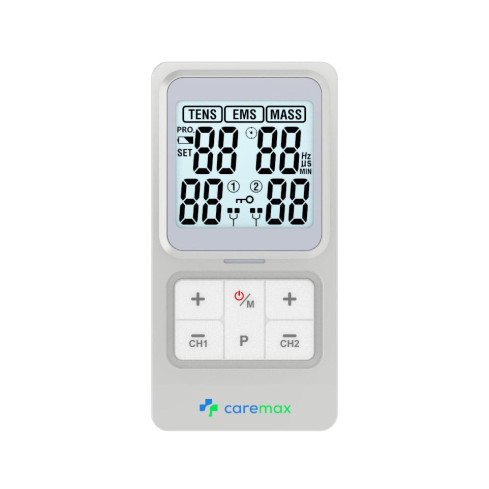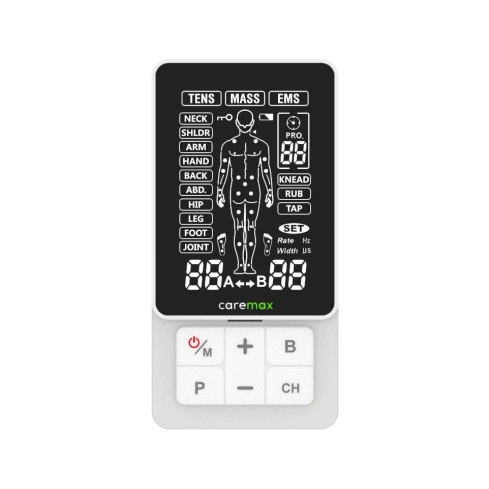Product added to cart
- Home
- TENS & EMS
- How Effective is TENS Machine for Neuropathy Pain Relief?
How Effective is TENS Machine for Neuropathy Pain Relief?
Neuropathy pain, stemming from nerve damage or dysfunction, can be debilitating and challenging to manage. One promising approach is the use of Transcutaneous Electrical Nerve Stimulation (TENS) machines, which deliver controlled electrical currents to alleviate discomfort. Understanding how TENS machines can effectively target neuropathic pain offers hope for improved pain management and enhanced quality of life for those affected by this condition.
What is Neuropathy?
Neuropathy describes a condition that affects one or more nerves. A neuropathic condition can have several causes, including compression and injury. This can stem from several locations in the body, including the spinal cord, brain, and most commonly, the peripheral nerves. Often, neuropathy can present similarly, including numbness, altered sensation, and weakness. There are several types of conditions that can lead to neuropathy, including disc herniation, nerve impingement, and diabetes.
What Causes Neuropathy Pain?
Neuropathic pain is caused by an injury to the nerves. Types of injuries include compression, lacerations, inflammation, metabolic dysfunction, and autoimmune syndromes. These types of injuries can vary from trauma to overuse or systemic changes in the body.
Range of Neuropathy Symptoms
The range of neuropathy symptoms will vary depending on the type, severity, and location of the injury. Common neuropathy symptoms include:
- Pins and needles
- Numbness
- Radiating aches or pains
- Muscle weakness
- Altered or loss of sensation
- Reduced balance
- Cramps and muscle switching
- Changes in skin, hair, and nails
- Nerve pain
What is a TENS machine, and How can it help with neuropathy pain?
A TENS machine is an electrical device that is used to help reduce different types of discomfort, including neuropathy pain and muscle aches. The TENS machine delivers specifically programmed electrical signals through the gel electrodes placed on the skin. These electrical currents penetrate into the deeper layers of the body (i.e., muscles, nerves, etc.) to assist with pain relief [1].
Higher frequency settings on a TENS machine assist with immediate acute pain relief. Normally, pain is an unpleasant sensation that travels from the injured area to the brain, where it is then perceived. Lower-frequency settings, on the other hand, assist with more prolonged pain relief by stimulating the body’s release of endogenous opioid proteins [2].
Using Caremax TENS machine for Nerve Pain Relief
Discover the most sought-after products below essential for effective treatment.
 |
 |
| Caremax 2.0 Classic TENS machine | Caremax 2.0 Pro TENS Machine |
What's the best way to use a TENS machine for neuropathy pain relief?
A TENS machine can be used to assist with neuropathy pain. It can be used to assist with in-the-moment relief from symptoms or before events that may increase symptoms. How you optimally set, position and use a TENS machine will vary from person-to-person and circumstantially. In the preceding paragraphs, we will discuss the potentially most appropriate way to use your TENS machine.
Here are the best practices for using a TENS unit:
-
Position of electrode pads for neuropathy pain
The positioning of the electrode pads will be determined by several factors, including the location, cause, and severity of the symptoms. Typically, the pads will be positioned around the symptomatic area(s) [2]. In some circumstances, those with referred pain from the neck or back may experience relief when placed around these areas. Please speak to a relevant healthcare professional, such as your physiotherapist or doctor, about these problems.
-
Conductive garments as an alternative to electrode pads
For some people, nerve pain or neuropathy pain can spread to specific areas of the body. For instance, those with carpal tunnel syndrome may experience more pain through the hands and fingers. As a result, conductive garments may be worn in place of the electrode pads. This may allow for a more convenient and targeted approach. A list of conductive pads will be highlighted below:
Sock-conductive garments for the ankle and foot
-
Setting the TENS Mode for Neuropathy Pain
There are several TENS modes when considering optimal treatment for neuropathy. This can be highly dependent on the user and may require self-adjustment to find the most effective setting. Settings that can be adjusted include frequency, intensity, and pulse width. Both pulse width and frequency are usually set before the treatment. On the other hand, the intensity (mA) can be adjusted during the treatment depending on the user’s characteristics. Studies have shown that the intensity should be set so that the user experiences a comfortable tingling sensation [3]. Those experiencing nerve pain should be weary to avoid sudden increases in intensity, as their sensations may be affected.
-
Setting the Pulse Rate (Frequency) for Neuropathy Pain
The frequency of the TENS treatment can be split into low- and high-frequency settings. Higher-frequency settings above 100 Hz stimulate the sensory nerve fibres, which can help block pain signals related to neuropathy [4]. On the other hand, low-frequency settings from 1-3 Hz are thought to stimulate certain nerve pathways to assist with the release of pain-relieving endorphins in the body [5].
At this point, there does not seem to be a consensus as to whether low- or high-frequency settings are more effective for neuropathic pain. There are studies that support either high [4] or low frequency [5] settings for more effective neuropathic pain relief. Preferences for frequency settings may differ from person to person.
-
Setting the Pulse Width for Neuropathy Pain
Currently, more research may be required about choosing which pulse width is effective for neuropathy pain relief [2] [3]. According to a Cochrane review [3], a range of 50µs to 250µs was used to treat nerve pain.
-
How Often Should You Use Your TENS Machine for Neuropathy Pain?
How often TENS machines should be used to treat neuropathy pain will vary from person to person. Studies have shown that using the TENS machine for 2x30 minute sessions 3-5 times a week is beneficial for neuropathy pain relief [3].
Other Home Remedies to Relieve Neuropathy Pain
There are several different types of home remedies that can help relieve neuropathy pain, including:
- Corrective exercises
- Stretches
- Mirror therapy
- Massage
- Heat packs
- Cold packs
- Exercise
- Medicated and/or natural ointments
- Meditation and mindfulness strategies
- A warm bath or shower
Where and when to not use TENS machines
Using transcutaneous electrical nerve stimulation (TENS) machines can offer relief for various conditions, but their application requires careful attention to safety guidelines. Following these precautions is vital for safe and effective use. Below are essential safety measures that should be considered [7].
- Avoid applying the TENS machine to:
- Damaged skin (e.g., wounds, cuts).
- Areas with a lack of sensation or feeling
- Swollen areas.
- Near tumours or blood clots.
- Sites exposed to radiotherapy or radiation.
- Personal circumstances where a TENS machine should not be used or at least requires
- Pregnant women
- Individuals with implanted devices (e.g., pacemakers, neurostimulators).
- Those with cognitive or mental challenges
- Individuals who are able to give consent to TENS machine use.
- Specific safety measures for neuropathy pain or nerve pain. We recommend consultation with a healthcare professional before use in these circumstances.
- If you have a lack of sensation or feeling in the area applied
- Severe pins and needles and/or tingling.
- Be careful to avoid use if your symptoms worsen after usage.
Are there any risks of side effects when using a TENS machine?
While normal use of TENS is generally safe, understanding potential side effects is crucial. Typically, common side effects are mild in nature and can be prevented with careful usage. Being mindful to stop treatment at the earliest possible onset of adverse symptoms. More severe symptoms are generally more uncommon but also need careful attention and quick discontinuation at the earliest sign [7].
Commonly reported side effects include skin irritation and unusual sensations around the treatment area. For some people, this unpleasant sensation may actually resemble or worsen neuropathy pain. Please stop treatment immediately if this is the case and talk to a healthcare professional, such as a physiotherapist.
Less frequently encountered side effects may occur due to improper use, high-risk users (please refer to the previous paragraph), or application in unsafe areas. Individuals unsuitable for TENS treatment may experience more pronounced side effects, such as rashes, increased pain, seizures, interference with implanted medical devices, strokes, blood clots, skin damage, and burns.
References
- Johnson, M. I., & Bjordal, J. M. (2011). Transcutaneous electrical nerve stimulation for the management of painful conditions: focus on neuropathic pain. Expert Review of Neurotherapeutics, 11(5), 735-753.
- Watson, Tim. "Transcutaneous electrical nerve stimulation (TENS)." Physiopedia. Available online: https://www. physio-pedia. com/Transcutaneous_Electrical_Nerve_Stimulation_ (TENS)(a
- ccessed on 4 March 2022) (2010).
- Gibson, W., Wand, B. M., & O'Connell, N. E. (2017). Transcutaneous electrical nerve stimulation (TENS) for neuropathic pain in adults. Cochrane Database of Systematic Reviews, (9).
- Al-Zamil, M., Minenko, I. A., Kulikova, N. G., Alade, M., Petrova, M. M., Pronina, E. A., ... & Shnayder, N. A. (2022, January). Clinical experience of high frequency and low frequency TENS in treatment of diabetic neuropathic pain in Russia. In Healthcare (Vol. 10, No. 2, p. 250). MDPI.
- Kulikova, N., Khalilovich, A. Z. M., Konchugova, T., Rachin, A., Chkheidze, T., Kulchitskaya, D., ... & Ivanova, E. P. (2022). Analgesic effects of high-frequency and low-frequency TENS currents in patients with distal neuropathy. European Journal of Translational Myology, 32(3).
- University of Iowa Hospitals & Clinics. (2018). Contradictions and Precautions. Retrieved from https://www.healthcare.uiowa.edu/marcom/uihc/pain_medicine/contraindication_precautions_best062018.pdf
Categories
- TENS & EMS (19)
- Latest News (41)
- Massager (2)
- Nebuliser (8)
- Skin Care (3)
- Period Pain Management (1)
- Fitness (2)